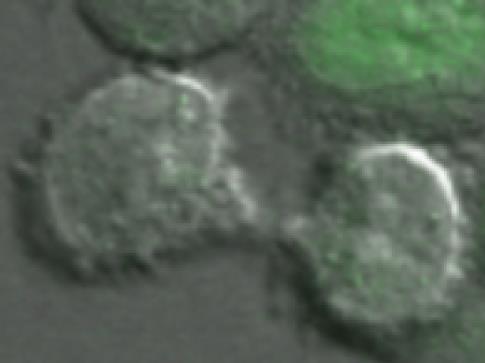
Image: Dr Chris Bakal
Researchers have made a major discovery about how cells control when to divide – representing a step forward in scientists’ understanding of one of the most fundamental processes of life.
Their study has revealed a ‘safety catch’ within cells that prevents them from dividing until DNA is allocated equally to the two daughter cells.
It could lead to new treatments that prevent cancer cells from dividing, or kill them by forcing them to divide prematurely.
A research team from The Institute of Cancer Research, London, The University of Cambridge and University College Dublin set out to reveal the role of a key part of the cellular machinery which helps to govern cell division.
The study is published on Thursday 8 December 2016 in the journal Molecular Cell and was funded by Cancer Research UK, Wellcome, Science Foundation Ireland and the European Union.
Blocking cell division
The researchers examined the role of a molecule called BubR1 in mitosis – the process during which a cell copies its chromosomes and pulls them apart into two separate cells.
BubR1 forms part of a molecular machine which prevents cells from dividing until they are ready by stopping the two sets of chromosomes from being pulled apart.
The team focused in on a small part of BubR1 which has been conserved across evolution in all the kingdoms of life except bacteria – pointing to a fundamental function.
They removed normal BubR1 from cells, replacing it with an altered form which was misshapen in the crucial area. They then timed how long cells with mutant BubR1 could be held up in mitosis using time-lapse photography on high-powered microscopes.
The researchers found that cells with mutant BubR1 were unable to delay in mitosis as normal – meaning chromosomes were divided unevenly between daughter cells.
'Safety catch'
They concluded that the crucial part of BubR1 they were studying – which they called the ABBA sequence – acts as a safety catch, preventing the progression of mitosis until the chromosomes are properly positioned to be pulled apart.
Cancer cells rely on this safety catch much more than normal cells because they often have more chromosomes to get into place and so need more time in mitosis.
It might be possible to treat cancer by rushing cancer cells into premature division and potentially killing them by causing fatal errors within them.
Some drugs that force cancer cells into premature division are already undergoing clinical trials. The new study shows that new classes of small-molecule drugs that switch off BubR1’s safety catch could also be developed in the future.
Professor Jon Pines, Head of Cancer Biology at the ICR, said: “Our study has found a ‘safety catch’ in the cell division machinery, which prevents cells from dividing before they have confirmed that their chromosomes have been successfully aligned in the cell.
“In the future it might be possible to disable this safety catch in cancer cells with drugs – which would force cells into dividing before they are ready, and potentially kill them by introducing major errors into the division process.”
Important fundamental research
Professor Paul Workman, Chief Executive of the ICR, said: “Unravelling the complexity of cell division is fundamental to understanding cancer. We know cells rely on safety mechanisms to prevent them from dividing before they are ready, and these may be particularly crucial in cancer cells, with their complex, unstable genomes and extra chromosomes.
“If we could find a way to inactivate this safety catch, we might be able to kill cancer cells specifically by forcing them through division prematurely.”
Dr Áine McCarthy, Cancer Research UK’s Senior Science Communication Officer, said: “By looking at how cells divide, these scientists have identified a potential new way to destroy cancer cells, which could in the future lead to the development of new anti-cancer drugs. Early-stage studies like this highlight the importance of carrying out fundamental research which increases our understanding of how cells work – without this, no new treatments can be developed.”
